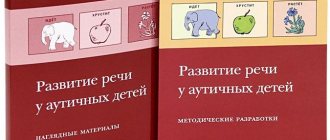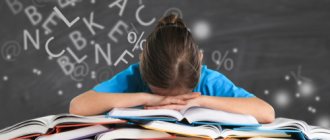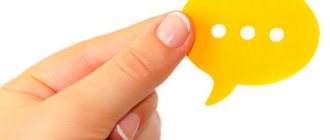Speech card for children with alalia; educational and methodological material on speech therapy on the topic
SPEECH CARD FOR CHILDREN WITH ALALIA
(General speech underdevelopment of levels I – II)
- Personal data:
- Last name, first name______________________________________________________________________________________________
- Date of Birth____________________________________________________________________________________
- Home address__________________________________________________________________________________
- Where did the child come from______________________________________________________________________________
- Start date of classes_______________________________________________________________________________
- Diagnosis of PMPK__________________________________________________________________________________________
- Conclusion No. ________________________ Duration of stay ___________________________________________
- Condition of hearing and vision ________________________________________________________________________________
- Speech activity: normal / below normal / no speech /_____________________________________________
- Understanding the speech of others: intact / reduced / significantly reduced /______________________________
- Was speech development interrupted?
II. Non-speech functions
- Attractiveness: attracted / requires additional stimulation / not attracted / _______________
- Contact: in contact / selectively in contact / does not come into contact / _____________________________
- Productivity: normal/below normal/low/extremely low__________________________________________
- Imitative activity
| Beginning of the year | The end of the year | |
| absence | ||
| action | ||
| word and action |
5. Perception
| Beginning of the year | The end of the year | ||
| Visual | "Find out the subject" in color, contour image; objects superimposed on each other, | ||
| Auditory | “Guess what it sounds like?” |
6. Understanding and distinguishing colors
| Beginning of the year | The end of the year | |||
| shows | calls | shows | calls | |
| Red | ||||
| Yellow | ||||
| Green | ||||
| Blue | ||||
7. Understanding different quantities
| Beginning of the year | The end of the year | |||
| shows | calls | shows | calls | |
| Big | ||||
| Small | ||||
8. Distinguishing and naming geometric shapes
| Beginning of the year | The end of the year | |||
| shows | calls | shows | calls | |
| Circle | ||||
| Square | ||||
| Triangle | ||||
9. State of memory and attention
| Beginning of the year | The end of the year | |||
| visual and visual | “Remember which toy is missing?” | |||
| "What changed?" | ||||
| auditory and auditory: | "Clap like me" | I | ||
| II | ||||
| III | ||||
| I - II | ||||
| I - III | ||||
| II - I | ||||
| II - II | ||||
| "Remember and Repeat" (syllable chains) | Mother | |||
| ma - mu | ||||
| ma - pa | ||||
| ma - pu | ||||
| ma - mu - mi | ||||
10. Constructive visual memory
| Beginning of the year | The end of the year | |||
| according to the model | by memory | according to the model | by memory | |
| triangle | ||||
| square | ||||
| bed | ||||
| high chair | ||||
- Thinking
| Beginning of the year | The end of the year | ||
| "Seguin Board" | |||
| Pyramid of 3-4 rings | |||
| “Make the Whole” (pictures, cubes) | 2 parts | ||
| (3-4) parts | |||
12. Nature of play activity: enters / does not enter into play / manipulates objects / plays nearby / play according to age / ________________________________________________________________________________________________
III. General and fine motor skills.
| Beginning of the year | The end of the year | ||
| Gross motor skills and spatial orientation | Show how the bunny jumps | ||
| Show how the bear walks | |||
| Put your hands up | |||
| Put your hands down | |||
| Hide your hands behind your back | |||
| Show me your right hand | |||
| Show your left hand | |||
| Jump up | |||
| Stand on one leg | |||
| Fine motor skills | "The birds are pecking the grain" | ||
| "Hare" | |||
| "Ring" | |||
| Clench and unclench your fist | |||
| Switching from one pose to another | "Fist - palm" | ||
IV. The structure of the articulatory apparatus, articulatory motor skills, speech breathing.
1. Anatomical structure of the articulatory apparatus:
- Lips (thick, thin, cleft, scars)___________________________________________________________
- Teeth (sparse, crooked, small, absent, outside the jaw arch) _________________________________________
- Jaws, bite (prognathia, progenia, open lateral, open anterior, cross)_______________
- Hard palate (high narrow, gothic, flat, cleft, subcumulous cleft)__________________________
- Soft palate (short, bifurcated, lack of a small tongue)__________________________________________
- Tongue (massive, small, with shortened hyoid ligament)__________________________________________
- State of respiratory and vocal function:
- Type of breathing: upper clavicular / diaphragmatic / abdominal / mixed / _____________________________
- Breathing volume: sufficient/insufficient/__________________________________________________________
- Direction of air flow during speech: through the mouth / through the nose / _________________________________
- Voice volume: excessively loud or soft/ muffled/ monotone/ nasal/ ___________
3. Nonverbal types of communication
| Beginning of the year | The end of the year | |
| use of facial expressions | ||
| gestures |
- completely replaces verbal communication
- actively uses
- as an aid to communication
- does not use
- State of articulatory motor skills:
| Beginning of the year | The end of the year | |
| Open your mouth wide | ||
| "Smile" | ||
| "Tubes" | ||
| "Spatula" | ||
| "Sting" | ||
| "Swing" | ||
| "Pendulum" |
Features: synkinesis, increased salivation, deviation of the tip of the tongue to the right/left, tremor, muscle hypertonicity / muscle hypotonicity, difficulties in finding an articulatory position, difficulties in maintaining an articulatory position, cyanosis of the tongue ___________________________________________________________________________________
V. Speech function
1. Study of the impressive side of speech.
1. Understanding speech at the dialogue level:
What is your name? _______________________________________________________________
Which toy did you like? _________________________________________________
Show me how you can play with a doll (car)? ____________________________________
2. Understanding the instructions:
| Beginning of the year | The end of the year | |
| Take the ball | ||
| Give me the doll | ||
| Throw the ball on the floor | ||
| Take the ball and give it to me |
3. Understanding words meaning:
| Beginning of the year | The end of the year | ||
| items | doll | ||
| car | |||
| uncle | |||
| aunt | |||
| cup | |||
| spoon | |||
| bread | |||
| cat | |||
| dog | |||
| boots | |||
| dress | |||
| jacket | |||
| a cap | |||
| actions | show who is drawing | ||
| is reading | |||
| costs | |||
| coming | |||
| is sitting | |||
| runs | |||
| lies | |||
| sleeping | |||
| eating | |||
| drinks | |||
| signs | big | ||
| small | |||
| hot | |||
| cold | |||
| sweet | |||
| sour | |||
4. Understanding phrases (based on pictures):
| Beginning of the year | Mid year | The end of the year | |
| The boy is walking | |||
| Kids are playing | |||
| Mom bathes baby |
5. Distinguishing between singular and plural meanings.
| Beginning of the year | The end of the year | ||
| Nouns | house - at home | ||
| table - tables | |||
| cup - cups | |||
| bird - birds | |||
| car - cars | |||
| Verbs | worth - worth | ||
| runs - run | |||
6. Understanding the meanings of nouns with diminutive suffixes:
| Beginning of the year | The end of the year | |
| house - house | ||
| chair - stool | ||
| ball - ball | ||
| cup - cup | ||
| ball - ball | ||
| doll - doll |
7. State of phonemic awareness:
| Beginning of the year | The end of the year | |
| Cat - whale | ||
| The house is smoke | ||
| Bear - mouse |
2. Examination of the expressive side of speech:
- General characteristics of speech
| Beginning of the year | The end of the year | |
| Absence | ||
| Babbling speech | ||
| The beginnings of a phrase |
:
- Learning active dictionary:
| Beginning of the year | The end of the year | |||
| onomatopoeia | The girl has a toothache. | a-a-a | ||
| How does a girl (Lala) cry? | wow | |||
| The girl got lost. | aw | |||
| How does a cat scream? | meow | |||
| How does a dog bark? | aw-aw | |||
| Amorphous and babbling words (presence) | ||||
| Nouns | Logical groups | Toys | ||
| Cloth | ||||
| Dishes | ||||
| Pets | ||||
| Body parts | hands | |||
| legs | ||||
| head | ||||
| eyes | ||||
| mouth | ||||
| nose | ||||
| ears | ||||
| Machine parts | wheels | |||
| headlights | ||||
| steering wheel | ||||
| doors | ||||
| Verbs | coming | |||
| eating | ||||
| sleeping | ||||
| lies | ||||
- Grammatical structure of speech:
1) plural of nouns:
| Beginning of the year | The end of the year | |
| cat - cats | ||
| eye - eyes | ||
| house - at home | ||
| car - cars |
2) diminutive form of nouns:
| Beginning of the year | The end of the year | |
| house - house | ||
| table - table | ||
| knife - knife | ||
| hand - pen | ||
| machine - machine |
3) Agreement of nouns with pronouns “MY, MY, MY”:
| Beginning of the year | The end of the year | |
| a cap | ||
| bed | ||
| cube | ||
| dress | ||
| chair | ||
| ball |
4) Use of verbs in the imperative mood (“Command”):
| Beginning of the year | The end of the year | |
| stop | ||
| go | ||
| lie down | ||
| sleep | ||
| eat | ||
| play |
- Syllabic structure of words:
| Beginning of the year | The end of the year | |
| Mother | ||
| dad | ||
| woman | ||
| tata | ||
| Kate | ||
| Vania | ||
| shadows | ||
| horses | ||
| children | ||
| Panama | ||
| cubes | ||
| poppy | ||
| juice | ||
| house | ||
| rooster | ||
| sofa | ||
| banana | ||
| is sitting | ||
| walks | ||
| cat | ||
| jar | ||
| bear |
5. Sound pronunciation
| VOWELS | CONSONANTS | |||||||||||||||||||
| A | U | ABOUT | AND | E | Y | P | B | M | N | IN | F | T | D | TO | G | X | WITH | Y | l | |
| N.g. | ||||||||||||||||||||
| K.g | ||||||||||||||||||||
Conclusion:
____________________________________________________________________________________________________________________________________________________________________________________________________________________________________________________________________________________________________________________________________________________________________________________________________________________________________________________________________________________________________________________________________________________________________________________________________________________________________________________________________________________________________________________________________________________________________________________
Alalia.ru
Faced with working with speechless children , I had to study a lot of material. The first thing I experienced difficulty with was how to conduct a speech therapy examination of speechless children?
As a result, I compiled a speech map , which included all the main points necessary to get an idea of the defect. I think it will be of interest to beginning speech therapists, like me, who are grasping at any “straw.”
Speech therapy examination card for a speechless child
Preparatory part: Collecting anamnesis (questioning parents).
Main part: - Speech understanding (state of impressive speech, auditory attention, phonemic perception).
Study of auditory functions and phonemic perception
1. Presence of a reaction to the voice.
Call the child loudly behind his back E-H-HEY or AAA.
2. Discrimination of non-speech sounds.
Find out which toy makes a sound (first let both toys listen, the toys make noise behind the screen)
2 toys___________.
3 toys __________.
Repeat the action (stomp behind your back, clap your hands, hit the table).
3. Discrimination of speech sounds and the presence of a reaction to speech sounds.
Pronouncing two vowels (so that articulation is not visible) while showing a picture (for example, A - a doll is crying, U - a dog is whining). “Who said A? Who said U?” (if he pronounces it, he pronounces it himself).
Similarly, consonant sounds (if he pronounces them, he pronounces them himself).
Determining the volume and accuracy of the dictionary
1. Show toys: “Show me a doll (matryoshka, pyramid, bear).”
Modify the task: “Take a doll (matryoshka...).”
Give toys one by one: “Give me a doll (matryoshka...).
If you cope with the task, recognize familiar objects in the picture (cabinet, ball, cup).
Show everyday objects: table, chair, bed, cup, spoon, plate, shirt, dress, socks.
2. Knowledge of words of a general nature:
From objects grouped by topic: clothes, shoes, dishes, fruits, vegetables, toys, find certain items: “Find dishes” (toys, clothes, etc.).
Knowledge of body parts (arm, leg, head) and body parts of toy animals (paw, head, tail). “Show me your hand”, “Where is the bunny’s paw?”
3. Correlation of objects with their purpose.
Offer: apple, ball, toothbrush.
Questions: “What do you play with? What do you use to brush your teeth? What do you eat?".
Then replace the objects with object pictures and repeat the questions.
4. Finding out the volume of verbal vocabulary.
Lay out plot pictures in which the same person (a girl or a boy) performs various actions, give the opportunity to look at the pictures, and then show the desired one in response to the question: “Show where the girl walks (stands, runs, eats, sleeps, plays) , washes himself)".
“Show who is washing (standing, running).”
2 pictures are posted “Show me who is washing his face? Who's drying off? (eats/drinks, runs/walks, etc.).
5. Understanding the names of features of objects.
“Show me where the big table is? Where is the little one? (thick/thin stick, long/short ribbon, high/low house).”
“Which cube is bigger? Which one is smaller? (pencil longer/shorter, pyramid higher/lower).”
“Where is the red (yellow, blue) ball?”
Identification of differentiation of elementary grammatical forms
1. Understanding the singular and plural forms of the noun “Where is the doll?” Where are the dolls? (pyramid/pyramids, car/machines, book/books).”
2. Understanding prepositions reflecting spatial relationships. “Put the toy in the box (behind the box, under the box, in front of the box).”
3. Understanding diminutive suffixes. “Show me where the table is? Where's the table? (book/little book, doll/doll, box/box).”
Understanding sentences
Follow the instructions “Close your eyes (raise your leg, stroke the cat, bring the cube).”
Establishing the opportunity to remember and perform two actions formulated in one request “Take the bear and put it on a chair (go to the table and take a pencil, take the cubes from the table and put them in a box).”
Study of non-speech functions
1. Orientation in the surrounding space.
Show “top/bottom”, as well as directions: “Show me where the group is? (bedroom, physical therapy room, window, door).”
Give the child a piece of paper rolled into a tube (“spyglass”) and ask him to look through it and see objects on the window (cabinet, table, shelf).
2. Orientation on the plane.
In front of the child’s eyes, build a house from prepared parts (the house is a square, the roof is a triangle, the pipe is a rectangle) and ask: “Show me where the roof is? Where is the pipe?
3. The presence of postural praxis when simulating movements (in terms of general motor skills).
Invite your child to repeat certain movements after you (sit down, stand up, stomp, clap, shake your head, bend over, jump).
4. The presence of postural praxis when performing tests on fine motor skills, the possibility of differentiation of finger movements and the ability to switch.
Repeat sequentially the poses “fist”, “roof”, “boat”, “goat”, “circle”, “glasses”. Alternating two poses: “fist/palm”, “fist/goat”, “palms/boat”, “glasses/fist”.
Invite your child to touch each finger in turn, starting with the second thumb of the same hand.
5. Oral praxis.
Invite the child to imitate several actions: open his mouth wide; smile; puff out your cheeks; stretch your lips into a tube; make your lips as if making the sound [o]; stick out your tongue with a spatula; raise the tip of the tongue up; lower the tip of the tongue down; place the tip of your tongue in the right, then in the left corner of your mouth.
6. Ability to switch movements.
Invite your child to repeat two movements after you.
7. Constructive praxis.
Reproduce a figure from two, then three sticks according to the model, create a design from memory.
8. Formation of operations of visual-spatial analysis and synthesis and consistent implementation of constructive activities
Fold cut pictures from 2-3 parts with a straight edge; a lightweight version of Koos cubes; complete tabs on Seguin's board.
Study of nonverbal components of communication
1. Reaction to a stranger.
Invite your child to shake your hand.
A person unfamiliar to the child enters the office and starts a conversation with you.
2. Reaction to impression.
The child enters an office with a well-known environment. There is a new bright toy on the table.
3. Ability to imitate.
Encourage your child to copy your gestures and facial expressions.
Ask your child to show with a gesture the well-known actions of drinking, eating, sleeping, washing (hands), brushing (teeth), combing his hair, stroking (cat).
4. Modeling situations that facilitate the invocation of communicatively significant gestures (yes, no, I want, give).
Without verbal instructions, encourage your child to understand your gestures and expressive movements (pointing gesture, head nod, head shake, inviting gesture, denial gesture).
5. Ability to portray and play a role. - “Fly like a bird”, “Jump like a bunny”, “Stomp like a bear”, “An elephant is walking”, “A dog is running”, “A fox is sneaking”.
All proposed tasks must be emotionally charged and planned in such a way that the reaction to them can be minimal. Various means of stimulation and positive reinforcement of the child’s activities are used.
Conclusions:
If a speechless child does not have autistic manifestations, then the violations indicate the following.
Impaired auditory perception and understanding of speech indicates sensory alalia, expressed to varying degrees: from complete immunity to the sounds of speech and even the voices of people - to some ability to grasp the meaning of individual simple words and instructions.
If a child understands words and instructions, but unsteadily and imprecisely, he may have delayed speech development caused by some underdevelopment of sensory functions.
The presence of motor difficulties indicates motor alalia, expressed to varying degrees: from complete inability to make voluntary movements with the organs of speech (and even inability to accept help), to limited ability to perform imitation actions.
The latter may also indicate a delay in speech development caused by motor difficulties.
When sensory and motor disorders are combined, we need to talk about sensorimotor alalia. In this case, speech development delay is unlikely. FGR is possible if sensory and motor impairments are not too pronounced.
Speech therapy conclusion: _______________
Lazareva Irina Dmitrievna,
teacher-speech therapist, Mr. Moscow,
GBOU general developmental kindergarten No. 2583
Source: https://logoportal.ru/logopedicheskoe-obsledovanie-bezrechevyih-detey/.html




